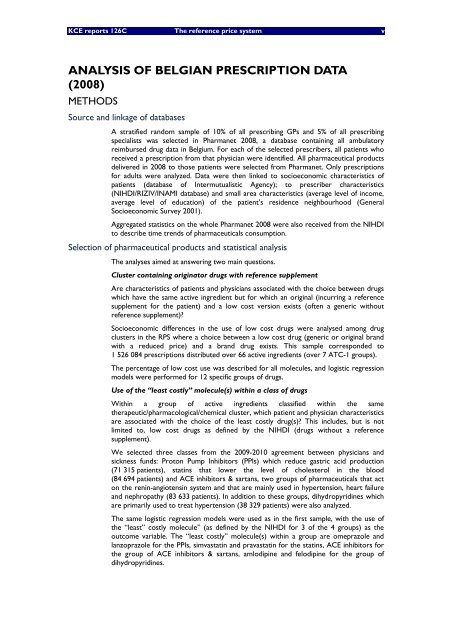The reference price system and socioeconomic differences in ... - KCE
The reference price system and socioeconomic differences in ... - KCE
The reference price system and socioeconomic differences in ... - KCE
You also want an ePaper? Increase the reach of your titles
YUMPU automatically turns print PDFs into web optimized ePapers that Google loves.
<strong>KCE</strong> reports 126C <strong>The</strong> <strong>reference</strong> <strong>price</strong> <strong>system</strong>. v<br />
ANALYSIS OF BELGIAN PRESCRIPTION DATA<br />
(2008)<br />
METHODS<br />
Source <strong>and</strong> l<strong>in</strong>kage of databases<br />
A stratified r<strong>and</strong>om sample of 10% of all prescrib<strong>in</strong>g GPs <strong>and</strong> 5% of all prescrib<strong>in</strong>g<br />
specialists was selected <strong>in</strong> Pharmanet 2008, a database conta<strong>in</strong><strong>in</strong>g all ambulatory<br />
reimbursed drug data <strong>in</strong> Belgium. For each of the selected prescribers, all patients who<br />
received a prescription from that physician were identified. All pharmaceutical products<br />
delivered <strong>in</strong> 2008 to those patients were selected from Pharmanet. Only prescriptions<br />
for adults were analyzed. Data were then l<strong>in</strong>ked to <strong>socioeconomic</strong> characteristics of<br />
patients (database of Intermutualistic Agency); to prescriber characteristics<br />
(NIHDI/RIZIV/INAMI database) <strong>and</strong> small area characteristics (average level of <strong>in</strong>come,<br />
average level of education) of the patient’s residence neighbourhood (General<br />
Socioeconomic Survey 2001).<br />
Aggregated statistics on the whole Pharmanet 2008 were also received from the NIHDI<br />
to describe time trends of pharmaceuticals consumption.<br />
Selection of pharmaceutical products <strong>and</strong> statistical analysis<br />
<strong>The</strong> analyses aimed at answer<strong>in</strong>g two ma<strong>in</strong> questions.<br />
Cluster conta<strong>in</strong><strong>in</strong>g orig<strong>in</strong>ator drugs with <strong>reference</strong> supplement<br />
Are characteristics of patients <strong>and</strong> physicians associated with the choice between drugs<br />
which have the same active <strong>in</strong>gredient but for which an orig<strong>in</strong>al (<strong>in</strong>curr<strong>in</strong>g a <strong>reference</strong><br />
supplement for the patient) <strong>and</strong> a low cost version exists (often a generic without<br />
<strong>reference</strong> supplement)?<br />
Socioeconomic <strong>differences</strong> <strong>in</strong> the use of low cost drugs were analysed among drug<br />
clusters <strong>in</strong> the RPS where a choice between a low cost drug (generic or orig<strong>in</strong>al br<strong>and</strong><br />
with a reduced <strong>price</strong>) <strong>and</strong> a br<strong>and</strong> drug exists. This sample corresponded to<br />
1 526 084 prescriptions distributed over 66 active <strong>in</strong>gredients (over 7 ATC-1 groups).<br />
<strong>The</strong> percentage of low cost use was described for all molecules, <strong>and</strong> logistic regression<br />
models were performed for 12 specific groups of drugs.<br />
Use of the “least costly” molecule(s) with<strong>in</strong> a class of drugs<br />
With<strong>in</strong> a group of active <strong>in</strong>gredients classified with<strong>in</strong> the same<br />
therapeutic/pharmacological/chemical cluster, which patient <strong>and</strong> physician characteristics<br />
are associated with the choice of the least costly drug(s)? This <strong>in</strong>cludes, but is not<br />
limited to, low cost drugs as def<strong>in</strong>ed by the NIHDI (drugs without a <strong>reference</strong><br />
supplement).<br />
We selected three classes from the 2009-2010 agreement between physicians <strong>and</strong><br />
sickness funds: Proton Pump Inhibitors (PPIs) which reduce gastric acid production<br />
(71 315 patients), stat<strong>in</strong>s that lower the level of cholesterol <strong>in</strong> the blood<br />
(84 694 patients) <strong>and</strong> ACE <strong>in</strong>hibitors & sartans, two groups of pharmaceuticals that act<br />
on the ren<strong>in</strong>-angiotens<strong>in</strong> <strong>system</strong> <strong>and</strong> that are ma<strong>in</strong>ly used <strong>in</strong> hypertension, heart failure<br />
<strong>and</strong> nephropathy (83 633 patients). In addition to these groups, dihydropyrid<strong>in</strong>es which<br />
are primarily used to treat hypertension (38 329 patients) were also analyzed.<br />
<strong>The</strong> same logistic regression models were used as <strong>in</strong> the first sample, with the use of<br />
the “least” costly molecule” (as def<strong>in</strong>ed by the NIHDI for 3 of the 4 groups) as the<br />
outcome variable. <strong>The</strong> “least costly” molecule(s) with<strong>in</strong> a group are omeprazole <strong>and</strong><br />
lanzoprazole for the PPIs, simvastat<strong>in</strong> <strong>and</strong> pravastat<strong>in</strong> for the stat<strong>in</strong>s, ACE <strong>in</strong>hibitors for<br />
the group of ACE <strong>in</strong>hibitors & sartans, amlodip<strong>in</strong>e <strong>and</strong> felodip<strong>in</strong>e for the group of<br />
dihydropyrid<strong>in</strong>es.
















